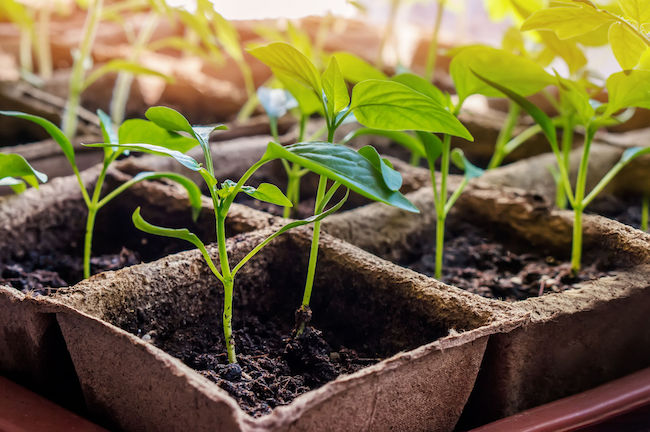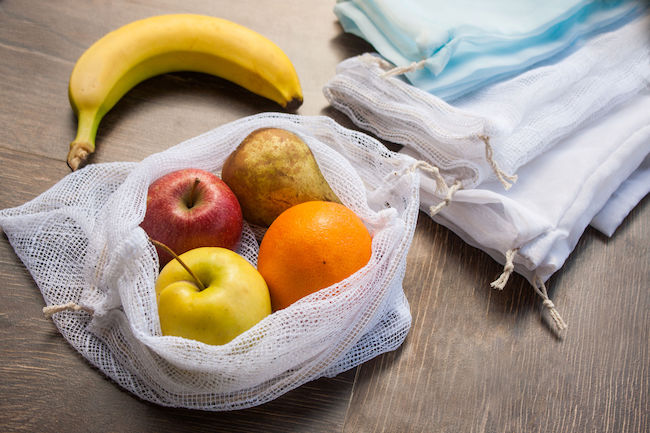
When you picture farming, plastic probably isn’t on your mind. However, plastic has become a huge part of modern agriculture. It’s part of the entire farming process, from the plastic trays seedlings are started in, to the black plastic sheeting covering fields to keep weeds down, to the packaging when products make their way to market. Plastic is so ingrained in food and farming, there’s a term for it: plasticulture. As part of our mission to support ecologically sustainable farm management practices, we’d like to see this ubiquitous use of ag plastics change.
Sadly for modern farmers, ditching plastic can be tough if they want to compete with other farms bringing affordable, high quality produce to market. While some things like plastic greenhouse covers can be tough to replace, there are a few ways farmers can decrease their reliance on plastic.
1. Avoid using black plastic sheet mulch. Plastic sheet mulch obviously keeps weeds down, thus keeping labor costs lower; however, one of the biggest arguments in its favor is that it helps keep the soil moist and decreases water use. In drought-prone areas, this is a big deal. Thankfully there are some alternatives to plastic mulch. Cover crops are an excellent choice, especially between rows. They hold water and soil in place, outcompete weeds, and can help increase fertility. Natural mulches like straw or leaves can also be used. These hold in moisture and help prevent weed growth.
2. Whenever possible, sell products in bulk fashion and encourage consumers to bring their own containers or use non-plastic containers. Not everything can be sold in bulk, but most fresh produce can be easily sold without plastic if customers bring their own bags. For other products like honey and maple syrup, glass jars may be used in place of plastic. And cardboard egg cartons work just as well as those made of styrofoam.
3. Find alternatives to plastic seedling trays. Some great options for this include peat pots, soil blockers, or paper pots. Soil blocks can greatly reduce expense, as there’s no need to buy new trays, and paper pots can be used with paper pot transplanters making the process quick and efficient.
4. Use less drip tape. Drip tape is a wonderful way to water crops without a lot of water evaporating off. However, it uses a lot of plastic to transfer water to large fields of crops. There are a couple of ways to use less. The first is to avoid using it all together—opt for drought-tolerant crop varieties wherever possible and use natural mulch and cover crops to help keep soil moist. When drip tape is a necessity, the second option is to purchase high-quality tape that will last through several seasons.
5. Consider alternatives to plastic transport crates. Transporting large quantities of produce to market is often done with plastic transport crates. While light and cheap, there is an alternative. Bamboo and wooden fruit crates are still available and can be used in place of plastic.

Farmers aren’t the only ones contributing to the plastic problem—it’s consumers too. Here are a few easy ways to cut down on plastic:
1. Buy fresh, local ingredients and cook from scratch. This is wonderful for several reasons. First, it’s a great way to eat more healthfully second, it supports local farmers; and lastly, it’s an excellent way to find produce and other foods free from plastic packaging.
2. Take your own bags or containers to farmers markets or farm stands. Taking a few cloth grocery bags and reusable produce bags can make your shopping trip much more sustainable. Some farmers markets may even offer bulk maple syrup, honey, or fresh juice, so you may want to take a few mason jars as well.
3. Keep reusable cutlery, a container, and straws in your car or purse. If you’re someone who eats out a lot, having these few simple items can greatly reduce the amount of waste you create. Asking for no straw and no cutlery (if it’s not reusable) is an easy solution. Some restaurants may even be willing to put take-out in a reusable container for you, or you can use your own container for leftovers.
4. Store food without plastic. While you shouldn’t necessarily go home and throw away all your plastic containers, when the time comes to replace it, look for glass or metal containers instead. Mason jars or repurposed jars from items like spaghetti sauce and pickles make great containers if you’re on a budget. Also ditch the plastic wrap. Either place your food into a container or use a product like Bee’s wrap.
5. Grow your own food. Growing your own food, even if it’s just a few fresh herbs and cherry tomatoes, can help you keep a little plastic out of the landfill and save money. If you grow your own, you can make sure plastic is avoided at every stage from seed to plate.
If everyone made a few changes to eliminate plastics from farming and food, it would make a huge difference. Avoiding plastic decreases its production emissions and helps keep it out of waterways and landfills.
Jordan Charbonneau is an organic farmer and writer from West Virginia. She holds degrees in ecology and environmental humanities from Sterling College in Vermont.





Great post!! Thank you for the advice and tips!
So glad you found it useful Rebecca!